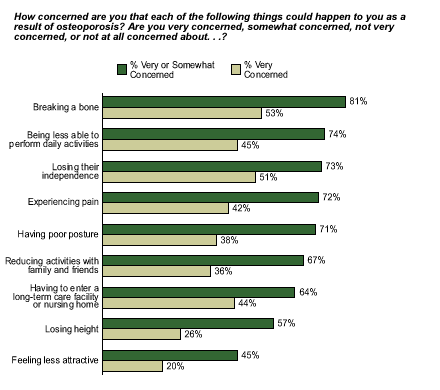A checkup from the family doctor or OB/GYN is a perfect opportunity for women to discuss important health concerns with a trusted professional. Unfortunately, most women, particularly those with lower incomes, do not talk about osteoporosis with their doctors unless faced with the disease. Gallup research conducted for the National Osteoporosis Foundation (NOF) in May 2000* found that 86% of women with osteoporosis never talked with their doctors about its prevention, and not surprisingly, 91% wish they had known more steps to prevent this highly debilitating, yet avoidable disease.
Osteoporosis is a disease that aggressively weakens bones, and is preventable if women develop habits that encourage bone health, such as regular exercise and diets rich in calcium. The disease affects nearly 10 million Americans, the majority of whom are women. Loss of bone density often results in chronic pain, vertebral fractures that can lessen height and compress organs, and hip fractures. A report for the Centers for Disease Control and Prevention (CDC), published in the Journal of the American Medical Association (JAMA) in January 1999, estimates hip fractures that occur among women with osteoporosis account for approximately 300,000 hospital admissions each year, resulting in approximately $9 billion in medical costs.
The cost to the individual is the greatest to consider, however, as most women who have osteoporosis worry about losing their ability to live independently and without pain. A new bill that passed through the New York State Assembly and Senate -- the Women's Health and Wellness Act -- requires employers and insurance companies to provide coverage for FDA-approved screening and treatment for osteoporosis. The same bill makes provisions for coverage of both cervical cancer and breast cancer screenings.
The following graphic gives some insight into the concerns of women who have osteoporosis, as gathered from the NOF/Gallup survey:

Women's socioeconomic status seems to be a factor in whether they discuss osteoporosis prevention with their doctors. In the overall Gallup/NOF sample, only 13% of women with osteoporosis reported having ever had a conversation with their doctor about osteoporosis prevention. Twenty-three percent (23%) of women with osteoporosis living in households with incomes of $50,000 and over reported having these conversations. This difference is likely attributable to the fact that women with higher household incomes have more access to healthcare resources and information.
Who should be responsible for broaching the subject -- the physicians or the patients? The NOF/Gallup study discovered that of those who had conversations about osteoporosis with their doctors before they were diagnosed, 47% reported that the doctor brought up the topic. Forty-four percent (44%) said that they were the ones to bring up the topic to their doctors.
The CDC and NOF have now partnered to encourage habits to improve bone health in girls, before they have attained most of their skeletal mass by age 20. Their "National Bone Health Campaign" includes ways to improve bone density by participating in bone-building physical activities (activities that require working against gravity, such as weight lifting) and consuming more calcium.
*The survey results are based on an entire sample of 1,039 women with osteoporosis. Results based on the entire sample of women with osteoporosis have a ±4% margin of error. Results based on the group of women who have experienced bone breaks have a margin of error of ±6%.